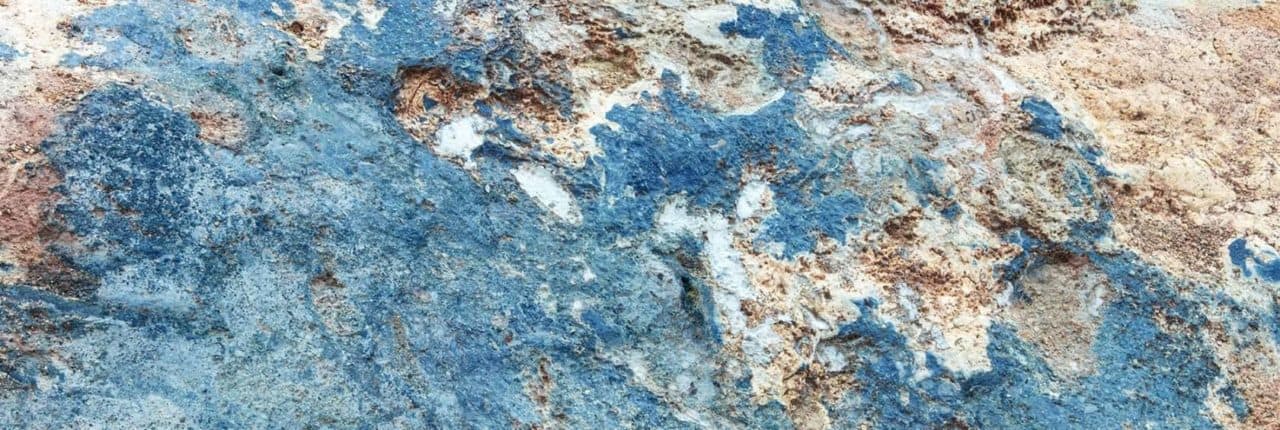Cobalt: A Resurging Commodity
Cobalt is en vogue in mineral exploration because of its position as a strategic resource. The increased global demand for battery-powered electric vehicles (BEV) has been reflected in the price surge in the market for all battery minerals, especially cobalt. As a principal component of BEVs, exploration for cobalt deposits is critical for continued progress in a green-energy transition and in the interest of national security. However, it is an extremely rare metal in the earth’s crust, and only a few nations can boast of significant reserves to meet this increasing global demand. With these considerations, how does it form, who currently controls known resources, and where could we look for new discoveries?
Background
Deep below the earth’s surface, past the lithosphere, the earth’s mantle is composed of ultramafic rocks, such as peridotite. As a transition metal amongst iron (Fe), nickel (Ni), copper (Cu), and zinc (Zn), cobalt is primarily concentrated in ultramafic rocks with average concentrations of 110 ppm. Extraction of these deep basement rocks, found 5 to 25 miles below the surface of the ocean and the continents, would be an uneconomical enterprise. On the surface of the ocean floor, manganese-cobalt crusts and nodules form as precipitates at the sediment-water interface. Current technological and economic restrictions hamper the extraction of these targets as well. How then do explorers find it in minable concentration at the earth’s surface?
Overall, cobalt concentration in crustal rocks averages 25 ppm. Enrichment of rock in cobalt occurs by a variety of processes. It can increase the concentration of it by a magnitude (10x) resulting in minable resources. Native cobalt is essentially non-existent. It most often occurs as a component of specific sulphides, selenides, arsenides, sulpharsenides, carbonates, sulphates, and arsenates. There are 34 known cobalt minerals. A few of the most recognized are cobaltite, linnaeite, and carrolite. It may also occur in hydrated oxides, such as absolane, or in the sulphides known as cobaltiferous pyrite. In almost all cases, cobalt extraction is intimately tied to either copper or nickel orebodies. It is produced as a by-product. In an exploration phase, it is pertinent to understand the genesis and types of cobalt orebodies that have been historically produced to better ascertain where future discoveries can be made.
Stratiform Sediment-Hosted Cobalt
Most known reserves of it occur in the Democratic Republic of the Congo and neighboring Zambia as sediment-hosted, Precambrian-aged (>540 Ma) deposits. In these sedimentary rocks, it is hosted in shale or sand-sized siliciclastic/carbonate units. It was entrained by diagenetic or metamorphic processes. Diagenesis and/or metamorphic processes mean that it was emplaced sometime after the rock was formed. What is the actual source of cobalt-bearing minerals? Most likely, this rare element is derived from peridotite in deeper, older basement rocks of the lithosphere. Possibly, it could be remobilized from pre-existing red beds. It could also be from primary sulphides deposited at the sediment-water interface by microbial processes. In these orebodies, it is indirectly produced as a by-product of copper production.
Magmatic Ultramafic Igneous Sources of Cobalt
Another well-studied source of cobalt is magmatic ultramafic igneous complexes such as the famous Stillwater Mine near Nye, Montana. These sources provide the highest average cobalt content, and it is typically found in dunite and serpentine. These primary, or hypogene, deposits, are found in Ni-Cu sulphides deposits such as the banded cumulates of the JM Reef. However, these types of deposits are primarily mined for nickel and copper, therefore it is a by-product. These layered ultramafic intrusions exist as the primary source for secondary, or supergene, cobalt deposits such as Ni-rich laterites which are discussed hereafter.
Red-beds with Cobalt Sulfides
Related to Ni-Cu sulfides found in layered ultramafic intrusive igneous rocks, is another moderately well-understood cobalt “play.” These secondary cobalt sources are Ni-rich laterites that result from the deep-seated weathering of basement peridotites as discussed in the previous section. Geographically these are restricted to subtropical to tropical climates with notable resources located in the South Pacific, Australia, and Cuba. It is produced in these localities is (surprise!) a by-product of nickel extraction.
Typically, nickel is concentrated in the saprolite. It’s also in weathered/decaying rock located immediately above the ultramafic bedrock. More significant quantities of it are found in the upper “red-beds” of limonite. Although over-simplified here, the primary controls of quality Ni-Co laterites are as follows: consistent tropical climate, near-surface ultramafic rocks, favorable geomorphological slope-factors, and a significant amount of time to weather and mobilize the elements into their ultimate, minable mineral states. Together, these conditions may result in minable concentrations of it.
Other Sources of Cobalt
In addition to the three styles of cobalt deposits discussed here, there are several other geological processes that result in the concentration of minable quantities of it in sulphides. These include black-shale deposits, skarns, iron-oxide-Cu-Au deposits, Mississippi Valley-Type sulfide deposits, and cobalt-bearing deposits that result from veins and volcanogenic processes. These variable deposits account for a small, but significant percentage of active cobalt producers.
Conclusion
As the global demand for cobalt increases, it has become increasingly important for explorers, producers, manufacturers, and governments to identify and exploit the home-grown resources. Whether through detailed exploration of new regions of interest or through renewed secondary exploration of brownfields, it is only a matter of time before new discoveries of cobalt burgeon the supply to meet these demands. Pioneering technology in resource recovery may push currently shelved projects into production by overcoming economic hurdles. Overall, the exploration of battery metals will continue to gain velocity. Especially as we hurtle towards the impending green revolution sweeping the globe.
Burgex Mining Consultants has experience planning and executing mineral exploration programs for cobalt and other critical minerals. From claim staking and mineral rights acquisition through drilling and feasibility – we have you covered. Contact us today for a free estimate.

References
Smith, C.G., 2001, Always the bridesmaid, never the bride: cobalt geology and resources, Applied Earth
Science 110, v. 2, p. 75-80.
Guilbert, J.M., and Park Jr., C.F., 2007, The geology of ore deposits. Waveland Press, Long Grove, Illinois.
Hein, J.R., and Petersen, S., 2013, The geology of cobalt-rich ferromanganese crusts, Secretariat of the
Pacific Community (SPC), p. 7-14.
Slack, J.F., Kimball, B.E., and Shedd, K.B., 2017, Cobalt, in Schulz, K.J., DeYoung Jr., J.H., Seal II, R.R., and
Bradley, D.C., eds., Critical Mineral Resources of the United States—Economic and Environmental
Geology and Prospects for Future Supply: U.S. Geological Survey, Professional Paper 1802-F, p. F1-F40.

